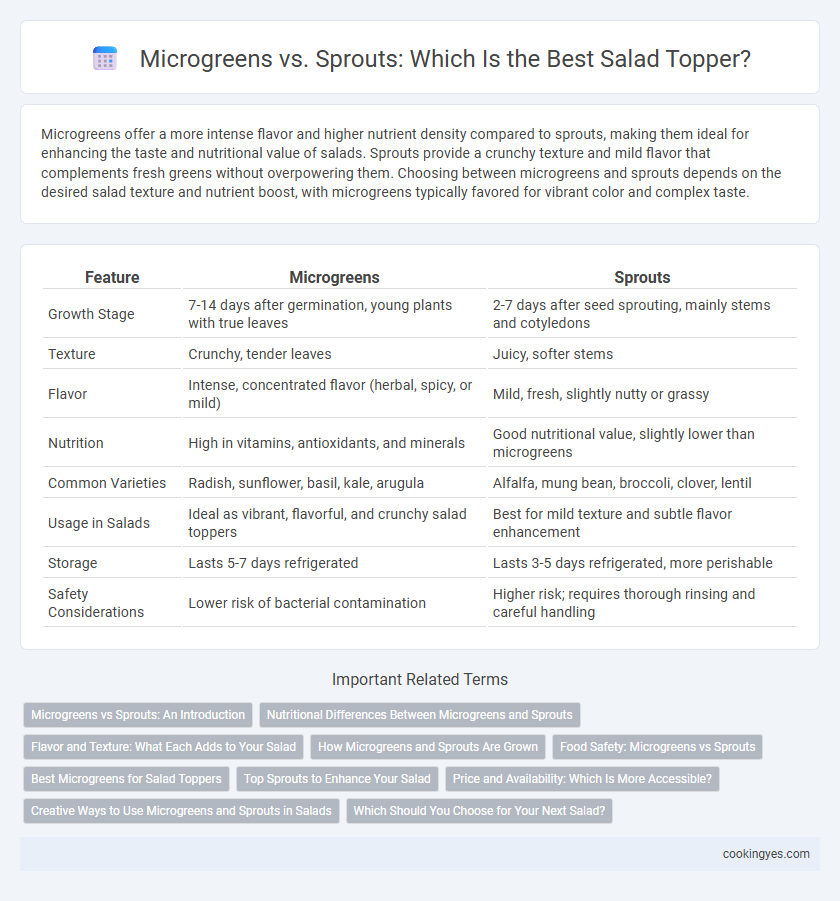Microgreens offer a more intense flavor and higher nutrient density compared to sprouts, making them ideal for enhancing the taste and nutritional value of salads. Sprouts provide a crunchy texture and mild flavor that complements fresh greens without overpowering them. Choosing between microgreens and sprouts depends on the desired salad texture and nutrient boost, with microgreens typically favored for vibrant color and complex taste.
Table of Comparison
| Feature | Microgreens | Sprouts |
|---|---|---|
| Growth Stage | 7-14 days after germination, young plants with true leaves | 2-7 days after seed sprouting, mainly stems and cotyledons |
| Texture | Crunchy, tender leaves | Juicy, softer stems |
| Flavor | Intense, concentrated flavor (herbal, spicy, or mild) | Mild, fresh, slightly nutty or grassy |
| Nutrition | High in vitamins, antioxidants, and minerals | Good nutritional value, slightly lower than microgreens |
| Common Varieties | Radish, sunflower, basil, kale, arugula | Alfalfa, mung bean, broccoli, clover, lentil |
| Usage in Salads | Ideal as vibrant, flavorful, and crunchy salad toppers | Best for mild texture and subtle flavor enhancement |
| Storage | Lasts 5-7 days refrigerated | Lasts 3-5 days refrigerated, more perishable |
| Safety Considerations | Lower risk of bacterial contamination | Higher risk; requires thorough rinsing and careful handling |
Microgreens vs Sprouts: An Introduction
Microgreens and sprouts are popular salad toppers that enhance flavor and nutrition with distinct characteristics. Microgreens are young vegetable greens harvested after the first true leaves appear, offering concentrated flavors and higher nutrient density compared to sprouts. Sprouts are germinated seeds harvested before the leaves develop, known for their crunchy texture but typically lower nutrient content than microgreens.
Nutritional Differences Between Microgreens and Sprouts
Microgreens contain higher concentrations of vitamins C, E, and K compared to sprouts, making them a nutrient-dense choice for salad toppers. Sprouts, while rich in enzymes and protein, often have lower overall antioxidant levels than microgreens. Incorporating microgreens enhances salads with greater amounts of essential nutrients and bioactive compounds.
Flavor and Texture: What Each Adds to Your Salad
Microgreens offer a concentrated burst of flavor with a tender yet slightly crunchy texture, enhancing salads with vibrant, diverse taste profiles ranging from peppery to sweet. Sprouts provide a milder, fresher flavor and a crisp, juicy texture that adds lightness and a refreshing crunch to salad toppings. Choosing between microgreens and sprouts depends on whether you prefer more intense flavor complexity or a delicate, crisp bite in your salad.
How Microgreens and Sprouts Are Grown
Microgreens are grown in soil or a soil substitute and harvested after the first true leaves develop, usually within 7 to 21 days, providing a nutrient-dense, tender texture for salad toppers. Sprouts germinate in water without soil and are harvested within 2 to 7 days, resulting in a crunchy, mild-flavored addition to salads. The growing medium and harvest time greatly influence the flavor, texture, and nutritional content of microgreens versus sprouts.
Food Safety: Microgreens vs Sprouts
Microgreens offer a safer alternative to sprouts as they grow above soil, reducing exposure to harmful bacteria like E. coli and Salmonella often linked to sprouts. Sprouts require warm, humid conditions that increase the risk of bacterial contamination, making them more susceptible to food safety issues. Choosing microgreens as salad toppers minimizes foodborne illness risks while providing fresh, nutrient-dense greens.
Best Microgreens for Salad Toppers
Kale, arugula, and sunflower microgreens stand out as the best microgreens for salad toppers due to their intense flavors and vibrant textures that enhance any salad mix. These microgreens provide higher nutrient concentrations than sprouts, including vitamins C, E, and K, essential for boosting salad nutrition. Their delicate yet crisp leaves hold up well in dressings, maintaining freshness and adding an appealing visual contrast to leafy greens.
Top Sprouts to Enhance Your Salad
Alfalfa sprouts, radish sprouts, and broccoli sprouts rank among the top choices to enhance your salad, offering concentrated nutrients and vibrant flavors. Rich in antioxidants, vitamins C and K, and enzymes, these sprouts boost the salad's health benefits while adding a crisp, peppery taste. Their delicate texture and potent nutritional profile make them superior salad toppers compared to microgreens.
Price and Availability: Which Is More Accessible?
Microgreens tend to be more expensive than sprouts due to longer growth periods and specialized growing conditions, impacting their overall accessibility for everyday salad toppings. Sprouts are generally more affordable and widely available in supermarkets and can be easily grown at home, making them a cost-effective option for frequent use. Availability of microgreens may vary seasonally, whereas sprouts maintain consistent accessibility year-round.
Creative Ways to Use Microgreens and Sprouts in Salads
Microgreens, packed with vibrant flavors and nutrients, enhance salads as colorful, crunchy toppers adding unique textures like peppery arugula or sweet basil varieties. Sprouts, such as alfalfa or mung bean, bring a crisp, fresh bite and subtle earthiness, perfect for layering with mixed greens or avocado slices. Combining microgreens and sprouts diversifies salad composition, elevating visual appeal and taste complexity in creative bowls and gourmet salad recipes.
Which Should You Choose for Your Next Salad?
Microgreens provide intense flavor and vibrant colors with a higher concentration of nutrients compared to sprouts, making them ideal for nutrient-dense salad toppings. Sprouts offer a crunchy texture and are quicker to grow, but they carry a higher risk of bacterial contamination due to their moist growing conditions. Choose microgreens for enhanced taste and nutrition, while opting for sprouts if you prefer a fresh crunch and speedier harvest for your salad.
Microgreens vs Sprouts for Salad Toppers Infographic

 cookingyes.com
cookingyes.com